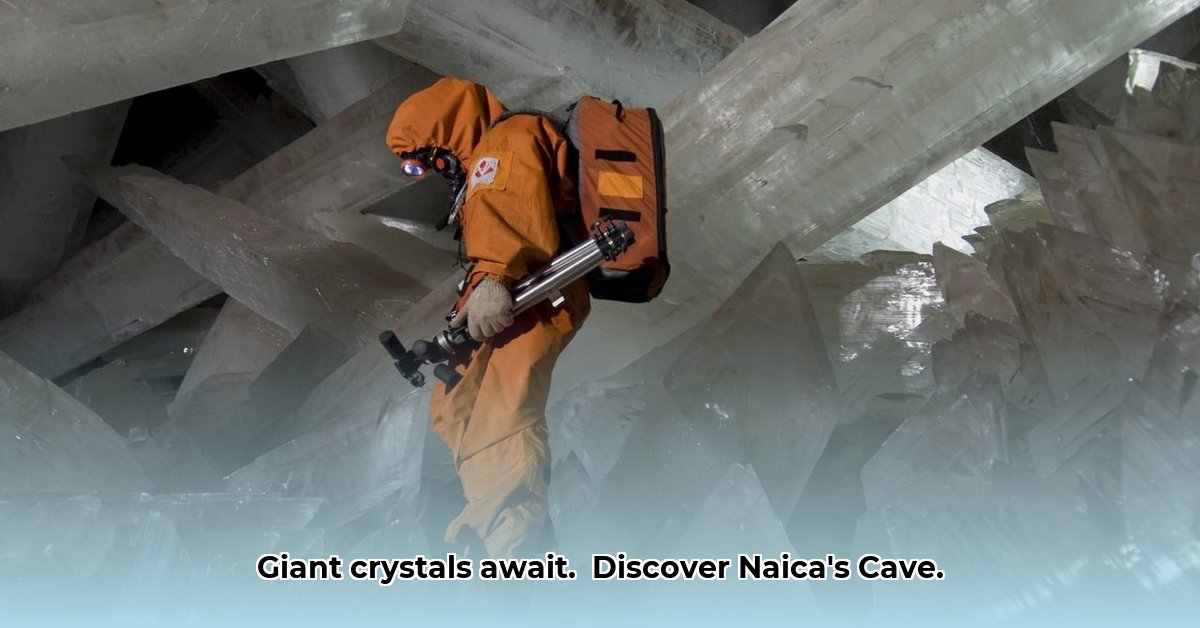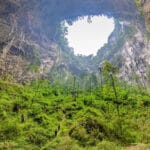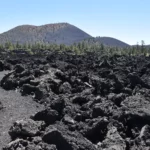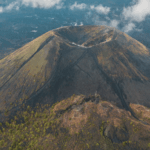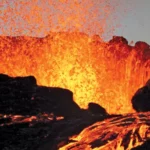Imagine venturing into a hidden realm beneath the Chihuahua Desert, where colossal crystals, taller than buildings, gleam in the darkness. This is the Cave of Crystals in Naica, Mexico – a breathtaking and mysterious geological marvel. For more on crystal formation, see this article on diamond formation. We’ll uncover the formation of these incredible crystals, the daunting challenges researchers face in studying them, and the future of this extraordinary site. Prepare for a journey into a world of giant crystals, scientific discoveries, and the ongoing race to preserve this natural wonder.
A Glimpse Inside: The Naica Cave’s Remarkable Gypsum Formations
Envision stepping into a cavern filled with colossal crystals, some longer than a city bus! This isn’t a scene from a science fiction film; it’s the astonishing Cave of Crystals, nestled deep within the Naica Mine in Chihuahua, Mexico. This subterranean wonderland is home to immense formations of selenite gypsum (a transparent, crystalline form of gypsum), a mineral that forms only under specific geological conditions. What makes this cave so exceptional?
A Serendipitous Discovery: Unveiling a Subterranean Geological Time Capsule
The cave’s discovery was a fortunate accident during routine mining operations. No one anticipated finding such a breathtaking spectacle hidden beneath the Earth’s surface. These enormous crystals, some measuring over 11 meters (36 feet) in length and weighing up to 55 tons, formed slowly over hundreds of thousands of years. This process unfolded underwater in a unique environment. Imagine incredibly hot, mineral-rich water saturated with dissolved anhydrite (a calcium sulfate mineral), gradually cooling. As the temperature slowly dipped just below 58°C (136°F), selenite gypsum – the primary component of these gigantic crystals – began to precipitate (solidify) out of the water. It’s an extremely slow geological process, gradually building these breathtaking structures over a timescale that is almost impossible for us to fully comprehend.
Extreme Conditions: The Challenges of Exploring the Naica Cave’s Harsh Environment
Exploring the Cave of Crystals is not a casual undertaking. The air inside is brutally hot, consistently around 45-50°C (113-122°F), with humidity levels reaching nearly 100%. Specialized equipment and training are essential for survival; it’s incredibly dangerous. This extreme environment poses significant preservation concerns. The crystals are fragile and vulnerable to minor changes in temperature, humidity, or air composition. These shifts could cause irreversible damage, including fracturing and clouding. Careful management of the mine’s water levels and air circulation is critical to maintaining the cave’s delicate equilibrium and protecting this natural wonder.
Unraveling the Secrets: The Science Behind Spectacular Crystal Growth
Scientists are driven to understand the processes that led to such extraordinary crystal growth. By studying the crystals’ structure and composition, researchers aim to refine models of mineral formation and gain insights into geological systems’ behavior over vast timescales. Research extends beyond mineralogy, contributing to a richer understanding of our planet’s history. What secrets do these colossal formations hold?
Life in the Extreme: Microbial Discoveries Within the Crystals
Scientists have discovered microscopic life forms inside these giant crystals! This discovery raises questions about extremophiles (organisms that thrive in extreme conditions) and the limits of life. The presence of these microbes underscores life’s adaptability and resilience, adding intrigue to this geological marvel. NASA Astrobiology Institute director Penelope Boston, who journeyed into the cave, helped identify microbial life trapped inside the crystals. Further investigation may reveal even more surprises.
The Future of the Cave: Balancing Research, Preservation, and Sustainable Practices
The long-term future of the Cave of Crystals depends on balancing our desire to study this unique environment with the need to preserve it for future generations. This balance may include restricted access, ongoing monitoring, and stringent environmental controls within the mine. Collaboration among stakeholders is essential.
A Collaborative Effort: Preserving This Global Treasure
Protecting the Cave of Crystals requires collaboration among stakeholders. Industrias Peñoles, the mining company that owns the site, has a critical role in implementing sustainable practices. Scientists require funding and access for research. The Mexican government establishes regulations and supports the scientific community. International organizations, such as UNESCO, can provide support and advocate for conservation.
| Stakeholder Group | Immediate Actions | Long-Term Goals |
|---|---|---|
| Industrias Peñoles | Implement enhanced water management systems and conduct rigorous risk assessments | Develop and implement a comprehensive long-term preservation plan, carefully manage access to protect the crystals from damage, and support research efforts. |
| Scientific Community | Conduct detailed lab analysis of samples and investigate microbial communities | Establish non-invasive monitoring techniques and foster multidisciplinary collaborations to maximize research impact. |
| Mexican Government | Enact stricter environmental regulations and secure funding for research and preservation efforts | Promote Naica as a geological tourism destination while prioritizing environmental protection and preservation. |
| International Organizations (UNESCO) | Advocate for UNESCO World Heritage Site designation and secure international funding | Facilitate international collaboration on best practices for cave preservation and promote global awareness of the site. |
The Cave of Crystals is a testament to nature’s wonders and the processes that shape our planet. Its preservation relies on the continued collaboration and dedication of all stakeholders.
The Challenge of Preservation: Protecting Naica’s Crystal Giants for Future Generations
- The Naica Cave’s selenite crystals are a unique geological wonder.
- Their preservation faces challenges due to the cave’s environment and vulnerability.
- Preserving Naica’s crystals requires a multi-faceted approach: research, sustainability, and protection.
- Balancing study and sharing with the need to protect is paramount.
The Geological Marvel of the Naica Cave
Imagine a cavern filled with gypsum crystals, some exceeding 15 meters (50 feet)! This is the Naica Cave in Chihuahua, Mexico. These crystals, primarily selenite gypsum, formed over millennia in a unique geological setting. Hydrothermal fluids (hot, mineral-rich water), saturated with dissolved minerals, slowly deposited gypsum, creating these formations. This environment is fragile.
Addressing the Cave’s Environment and Crystal Vulnerability
The Naica Cave presents preservation challenges. The extreme heat and humidity make working difficult and degrade equipment. The crystal structures are sensitive to changes in temperature and humidity. Human presence can have a negative impact through air circulation and moisture alteration. Microbial activity is another concern. How do we ensure these wonders endure?
Strategies for Naica Crystal Preservation
Preserving Naica’s crystals requires a comprehensive strategy:
- Strict Access Control: Limiting researchers and visitors reduces environmental impact through managed tours and monitoring systems.
- Environmental Monitoring: Continuous monitoring of temperature, humidity, and air quality is crucial. Sophisticated sensors and remote monitoring are essential.
- Advanced Research: Ongoing research is needed to understand crystal formation, microbial ecosystems, and the effects of human presence.
- Sustainable Practices: Implementing sustainable practices in the Naica mine is imperative to minimize further damage to the cave, including improved water management and reduced disturbance of the surrounding geological structures.
- Education and Outreach: Educating the public about the cave’s fragility and importance fosters a sense of responsibility and encourages support for preservation efforts.
- Innovative Tourism: Carefully planned and controlled tourism, potentially focusing on virtual or augmented reality experiences, could generate revenue for preservation while minimizing impacts.
- International Collaboration: Sharing knowledge and resources with experts worldwide aids in finding preservation solutions.
The Future of Naica Cave: A Shared Responsibility
The Naica Cave presents a responsibility to protect these crystals. Can we balance curiosity and sharing with ensuring endurance? The answer requires collaboration between scientists, policymakers, and the public. It’s an investment in preserving our planet’s heritage.
Extremophiles in Extreme Environments: Unveiling Microbial Life in Naica Cave
- Microscopic life, possibly dormant for millennia, has been discovered within Naica Cave’s crystals.
- These microbes, extremophiles, thrive in harsh conditions: heat, humidity, and darkness.
- Their survival raises questions about the limits of life and the potential for life beyond Earth.
- The potential for contamination during sample collection is an ongoing concern.
- Further research is vital to understanding survival mechanisms and evolutionary history.
Beneath the Mexican sun lies Naica Cave, filled with colossal crystals, a scientific treasure trove. Its allure lies not only in formations but also in its microscopic life: Extremophiles in Extreme Environments: Unveiling Microbial Life in Naica Cave.
Life Within a Crystal: Discovering Life Inside Gypsum Formations
Imagine giant crystals, some 11 meters long. Within these crystalline giants, scientists have discovered microscopic life: extremophiles thriving in conditions that would kill most life. Could you imagine living there?
How Organisms Thrive Under Harsh Conditions
The conditions inside Naica include extreme heat and humidity, total darkness, and mineral-rich waters. Life persists in this subterranean world. The tenacity of these microbes is remarkable, highlighting life’s adaptability and resilience. Scientists are still learning about what allows them to thrive.
Challenges and Discoveries: Contamination Concerns and Extremophile Findings
The discovery has challenges, as contamination is a concern. Ensuring the microbes discovered are truly indigenous is critical, and rigorous sterilization protocols are necessary. The possibility that these microbes have survived for tens of thousands of years in isolation is breathtaking. What secrets do these organisms hold about survival and evolution?
Implications: Beyond Naica Cave and Our Current Understanding
The implications of this discovery extend beyond the Naica cave, providing clues about life’s potential limits and influencing our understanding of planetary habitability. Their survival mechanisms may hold applications for biotechnology, medicine, and various other fields. Could similar extremophiles survive on other planets? The findings fuel the search for extraterrestrial life, expanding our understanding of the universe’s capacity for life.
Future Research and Exploration: Ongoing Investigation and Genetic Analysis
Further research will enhance our understanding of these unique extremophiles. The ongoing scientific investigation includes advanced genetic analyses, investigation of metabolic processes, and evolutionary paths. This work has implications for understanding astrobiology, particularly in the investigation of subsurface Martian environments. The Naica cave offers a window into the limits of life, and it’s an ongoing story still unfolding.
Balancing Act: Economic Impacts of Naica Mine Operations and Cave Preservation
The Naica Cave presents a paradox: its discovery, a byproduct of mining, revealed a geological wonder and threatened its existence. The mining process exposed the crystals to the atmosphere, initiating deterioration. What is the solution to balancing the economic benefits of the Naica mine with the imperative to preserve this ecosystem? Let’s explore the interplay between these forces.
The Delicate Balance: Mining, Preservation, and Financial Implications
The Naica mine, operated by Industrias Peñoles, unearthed the Cave of Crystals. With its colossal gypsum formations, it is a testament to nature’s artistry. However, the mining process—specifically draining the cave’s water table—exposed the crystals to the atmosphere, initiating deterioration. The crystals, accustomed to a stable, saturated environment for millennia, are now vulnerable to atmospheric changes. This leads to surface alteration and weakening, and crystal damage is inevitable with continued exposure.
The economic impacts are multi-faceted. The mine generates revenue and employment, however, neglecting the cave’s preservation could outweigh these gains. The cave’s scientific and tourism potential—if preserved—represents an untapped economic resource. Damage threatens this potential. What can be done to find a solution?
Preservation Strategies: A Complex Economic Decision
Refilling the cave with water would offer protection, but this would seal off access, eliminating tourism and research revenue. Creating a virtual reality replica could offer a compromise, however, developing such a recreation would be expensive. Controlled access, coupled with monitoring, is another avenue, but this demands investment in technology and infrastructure. Each option requires a cost-benefit analysis, factoring in economic losses and long-term gains from preservation. Can a solution be found that benefits all parties?
The Role of Key Stakeholders: Shared Responsibility and Economic Considerations
Successful preservation hinges on cooperation among stakeholders. Industrias Peñoles bears responsibility, and they must weigh their economic interests against their environmental obligation. The Mexican government plays a role in developing preservation policies. The scientific community can provide insights. Public awareness and support are vital.
Key Takeaways: Mine Operations and Economic Preservation
- The Naica Cave of Crystals faces degradation due to mine operations.
- Economic impacts are substantial, from mining revenue and potential losses from neglecting preservation.
- Preservation strategies include reflooding, virtual recreation, and controlled access, each with economic costs and benefits.
- Collaborative efforts between stakeholders are essential for effective preservation.
- The long-term economic value of preserving the cave—for science, tourism, and education—is likely greater than the short-term economic benefits of unrestricted mining.
- Sustainable mining practices that minimize environmental impact are crucial for balancing economic interests with preservation goals. By adopting responsible extraction techniques, Industrias Peñoles can contribute to the long-term viability of both the mine and the cave.
